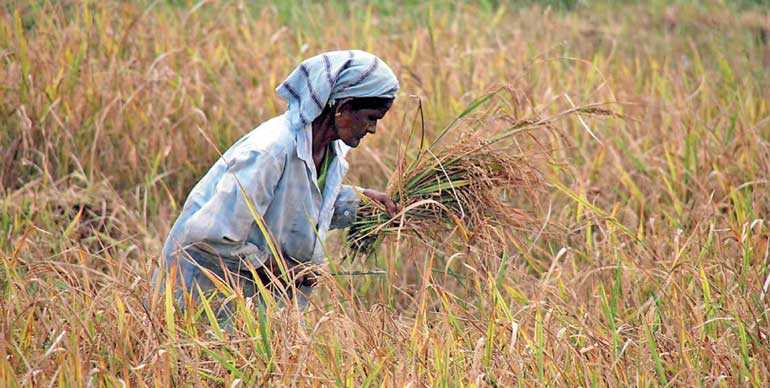Friday Jan 16, 2026
Friday Jan 16, 2026
Saturday, 31 August 2019 00:10 - - {{hitsCtrl.values.hits}}

A farmer harvesting paddy. Sri Lanka’s growth prospects remain positive despite liquidity issues and high debt financing challenges
– Pic by Shehan Gunasekera
International rating agency Moody’s yesterday said the credit profile of Sri Lanka (B2 stable) reflects ongoing Government liquidity and external vulnerability risks but expects continued focus on fiscal, monetary and economic reforms to lift growth potential.
Key credit challenges include large borrowing requirements, with a high reliance on external funding, and low foreign exchange reserves coverage of forthcoming economy-wide external debt maturities, Moody’s Investors Service said in its new report on Sri Lanka.
In addition, the Government has a very high debt burden, weak revenue generation and very low debt affordability. The volatile domestic political environment can also exacerbate refinancing risk, it warned.
However, Moody’s acknowledged the credit challenges are balanced against moderate per capita income levels and relatively strong institutions when compared to many similarly rated sovereigns.
“The Stable Outlook reflects balanced credit risks. Moody’s expects the Government will remain focused on implementing important fiscal, monetary and economic reforms that should strengthen the credit profile over the medium term.”
Nonetheless, Moody’s expects that the Government’s ability to refinance will remain highly vulnerable to sudden shifts in investor sentiment, further tightening in financing conditions, and political and policy uncertainty, with limited buffers to mitigate such risks.
“We would consider upgrading the rating if Sri Lanka’s vulnerability to refinancing risk were to materially decrease. In particular, a faster and more sustained build-up in non-debt creating foreign exchange inflows – which could stem from policy measures to improve investor confidence and enhance foreign direct investment inflows – would bolster reserve adequacy over time and lower Government liquidity and external vulnerability risks,” Moody’s said.
Additionally, further reforms that significantly lower fiscal deficits and Government debt and improve debt affordability could also prompt Moody’s to upgrade the rating. Conversely, the rating agency warned it would consider downgrading the rating if external and domestic financing conditions were to deteriorate further than currently expected.
In particular, a larger drain on foreign exchange reserves would sharply raise refinancing costs and increase the risk of lower capital inflows. This would contribute to repayment stresses that would be more consistent with a lower rating, Moody’s said.
“Additionally, we would also consider downgrading the rating if the Government were to reverse recent reforms or to halt implementation of future reforms to address fiscal and external vulnerabilities and bolster GDP growth potential. This would lead to much wider fiscal deficits, larger gross borrowing requirements and higher Government debt than we currently project, weighing on already very low fiscal strength and further heightening liquidity risks.”
Moody’s conclusions are contained in its just-released credit analysis on Sri Lanka, which examines the sovereign in four categories: economic strength, which Moody’s assesses as “moderate (+)”; institutional strength “low (+)”; fiscal strength “very low (-)”; and susceptibility to event risk “moderate (+)”.